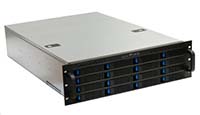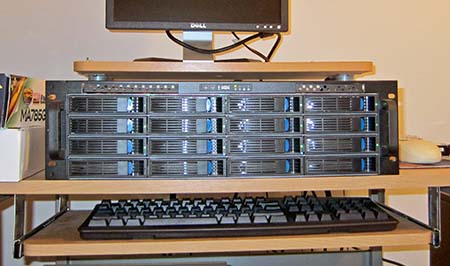Build your own media server, part 1: Hardware
 Are you drowning in terabytes of media files? Constantly running out of disk space to store your videos, music, and/or photos? Wouldn’t it be nice if you had a media server with vast reserves of storage where you could dump your ever-expanding digital collection without worrying about filling up your harddrive?
Are you drowning in terabytes of media files? Constantly running out of disk space to store your videos, music, and/or photos? Wouldn’t it be nice if you had a media server with vast reserves of storage where you could dump your ever-expanding digital collection without worrying about filling up your harddrive?
You may have even looked into buying or building a media server in the past, but perhaps were put off by high prices and/or complexity. What if I told you that you could build a power-efficient, high-availability, expandable media server without investing in any expensive specialized hardware (e.g.: no hardware RAID controllers, server-class processors or memory, or enterprise-level disks), and that you could be up and running in one afternoon—even if you don’t have any previous experience with this sort of thing?
How does 15 terabytes of storage for about $1,000 sound? Or 33TB of storage for under $2,000? How about if this server consumed less than 50 watts while idle (under 100 watts during normal operation)? Sound impossible? Read on to learn how.
A 50 watt, 33TB Media Server for under $2,000? How??
We’re going to be using unRaid, a linux-based operating system with a singular purpose: storing and serving files. Since it’s a barebones operating system, we can easily get away with using hardware that would be considered laughably underpowered in other scenarios, without negatively impacting our server’s performance at all. In fact, if you’ve got some old hardware sitting around, there is a good chance that you’ll be able to re-purpose it for use in an unRaid-based media server. In fact, the majority of our server’s cost is going directly into purchasing harddrives—we’re wasting very little of our total budget on non-disk hardware.
But before we can into the actual hardware, I want to get the limitations of an unRaid-based media server out of the way. If you need blazing-fast performance, look elsewhere. A server like this is meant to host media files: movies/videos, music, photos, etc. Performance will be more than sufficient to stream several high-definition videos simultaneously to multiple users without dropping frames, but you’re not going to break any speed records with file write times. If you’re using this server in the recommended manner (hosting/streaming media files), then you shouldn’t notice any difference in normal day-to-day usage versus a server with hardware costing ten times as much or more.
While unRaid gives you some protection from hardware failures—any one disk can fail without resulting in data loss—I want to stress that a media server with some built-in redundancy (whether it’s unRaid or hardware-based RAID) should not be considered a backup solution. You’ll still need to back up your data if you don’t want to risk losing it.
Finally, this server will pretty much strictly be for hosting files. If you want your media server to pull double-duty working on some other task(s), then running unRaid on low-power hardware might not be the best choice for you. You do have the option of running an FTP service from your unRaid media server, but that is about it.
What you’ll need
You’ll need the following to put together a respectable unRaid-based media server: a motherboard with as many SATA ports as possible (and one or more PCIe SATA expansion cards, if desired), a power-efficient CPU, a bunch of harddrives, and a case that will hold all of your drives. With unRaid, your hardware options are pretty flexible, but I recommend the following:
| Case | Norco server case with 12 drive bays | $259 |
| Motherboard & CPU | Supermicro X7SPA-H w/ Intel Atom D510 | $162 |
| Memory | 2GB RAM | $29 |
| Power Supply | Seasonic 550w gold-certified modular PSU | $79 |
| PCIe SATA/SAS card | Supermicro AOC-SASLP-MV8 | $104 |
| SATA/SAS cables | 2 x SFF-8087 breakout cables (1m) |
$14 each |
| Hard Drives | (up to) 12 x 3TB 5400 RPM low-power harddrives | $109 each |
| USB Flash Drive | 8GB USB Flash Drive (for unRaid OS) | $9 |
Let’s just get potential sticker-shock out of the way: the SATA/SAS card (& cables) is optional—you can run up to 6 harddrives without it. Two harddrives is the bare minimum with unRaid, but you certainly don’t need to buy all twelve at once (in fact, I recommend that you don’t—buy them as you need them to take advantage of falling prices and increasing sizes)! So for example, a media server with six 3TB harddrives would cost less than $1,200 and provide 15TB of usable storage. Adding additional drives beyond that point would require the purchase of a SATA/SAS card.
First, the case. I’ve opted for a Norco 12 bay rack-mountable server chassis here. There are a lot of options, but I like the Norco for a few reasons: it’s cheap (other 12-bay server cases cost 3-4 times as much), the drive bays are hot-swappable and easy to access (which makes drive replacements/upgrades a breeze), and 12 bays feels like enough for the average person’s needs. Norco also makes 16-bay (which is what I actually have), 20-bay, and 24-bay cases if you’d like more room to grow (unRaid currently supports up to 24 drives).
For the motherboard and CPU, my top choice is the Supermicro X7SPA-H with an integrated Intel Atom processor. In my opinion, you’re doing yourself and your wallet an incredible disservice by picking a traditional desktop or server processor here. The Atom D510 is more than powerful enough for unRaid, and the Supermicro motherboard gives you a generous 6 built-in SATA ports. However, the real advantage of picking the Atom CPU here is power consumption: the Supermicro motherboard, Atom CPU, and memory together consume under 30 watts at the wall (as measured with a kill-a-watt). The entire server with a full complement of 12 harddrives only uses about 45 watts with the drives spun down, and under 100 watts with all drives spinning! A traditional AMD or Intel “low-power” desktop processor (e.g.: a Sempron or Celeron) and motherboard combo will use around 150 watts by itself! If you’re planning to run your media server 24/7, the power savings are simply too significant to ignore.
The amount and speed of memory isn’t all that important—2GB is plenty for unRaid. If you’re using the Supermicro board that I recommend, just note that it takes SODIMM memory (typically found in laptops), and is reportedly somewhat finicky with regard to brand. The Crucial memory that I linked is recommended by Supermicro and should work fine. You can buy two sticks for 4GB of total memory, but unRaid won’t benefit much unless you’re running a bunch of plugins.
Some of you might scratch your heads at my power supply choice. A couple paragraphs ago, I mentioned that my entire recommended system only pulls about 100 watts at the wall during normal operation, yet I’ve recommended a 550 watt PSU. What gives—wouldn’t it be more economical to just buy a cheap 200 watt unit? My PSU recommendation isn’t so much about capacity, but efficiency and reliability. PSUs lose efficiency as they approach their peak rated power delivery, so having some headroom is always nice (during power on, the server will spike up to ~300w for a few seconds, too). The Seasonic is also 80 Plus Gold certified (and nearly 90% efficient), which will likely save you money in the long run compared to a cheaper unit. The modular design and near-silent operation are also nice pluses.
You’ll likely want to purchase the harddrives a few at a time, whenever you happen to see a good deal. I highly recommend 5400 RPM “green” drives—they’ll use less power, run cooler & quieter, and probably last longer than higher RPM drives. In a media server environment, there is no practical performance drawback to using slower 5400RPM harddrives—they’re still more than fast enough to stream multiple high-definition videos from. As of this writing, 3TB drives appear to be the price/storage “sweet spot” (3TB drives can be had for under $100 on occasion, but 4TB drives are still ~$170), but always check for deals on larger disks. You’ll likely want to order a couple of these if you’re filling all of your drive bays with disks.
You’ll also need a USB flash drive to boot unRaid from. Pretty much any quality 4GB+ USB stick should work. The 8GB Sony drive that I’ve recommended is the same one that Limeware (the creators of unRaid) recommends. I’ve used Sandisk and Lexar drives in the past without problems, so if you’ve already got a spare one laying around there is no need to order another. And of course, you’ll need an unRaid license, which you can purchase directly from the folks at Limeware (if you want, you can instead buy an unRaid license plus a pre-configured USB stick from Limeware, which will save you the few minutes that it takes to load it yourself).
You can max the server out with a full 12 drives for under $2,000. This gives you a whopping 33TB of usable storage with 3TB disks (in fact, if you care to mount a couple more harddrives internally, the motherboard + PCIe SATA/SAS card will actually support 14 drives, for a total of nearly 40TB of usuable space)! Using 4TB drives would get you over 50TB of usable space.
So now that the hardware is out of the way, how about getting unRaid loaded and configured? In the next part of our guide, we’ll take you through every step of the unRaid setup process, including how to make your media server visible to the other computers and devices on your network.

My unRaid media server. The monitor, keyboard, and mouse are attached to a KVM switch and mainly used to administer another server; management of the media server is normally done over the network.

Leave a Reply